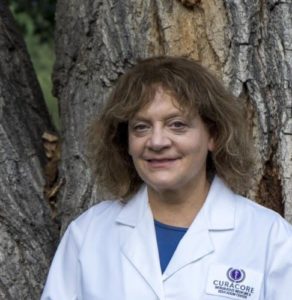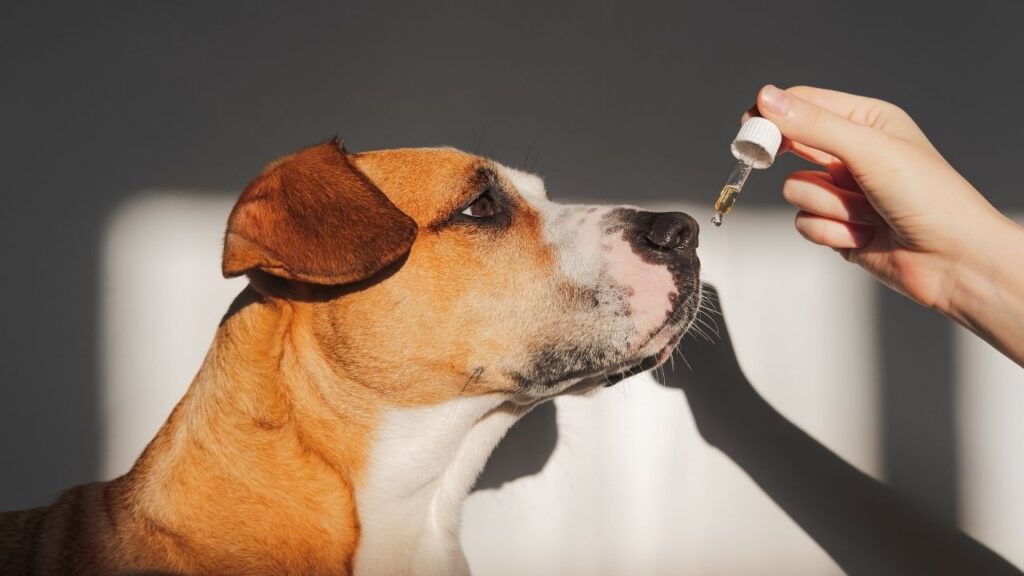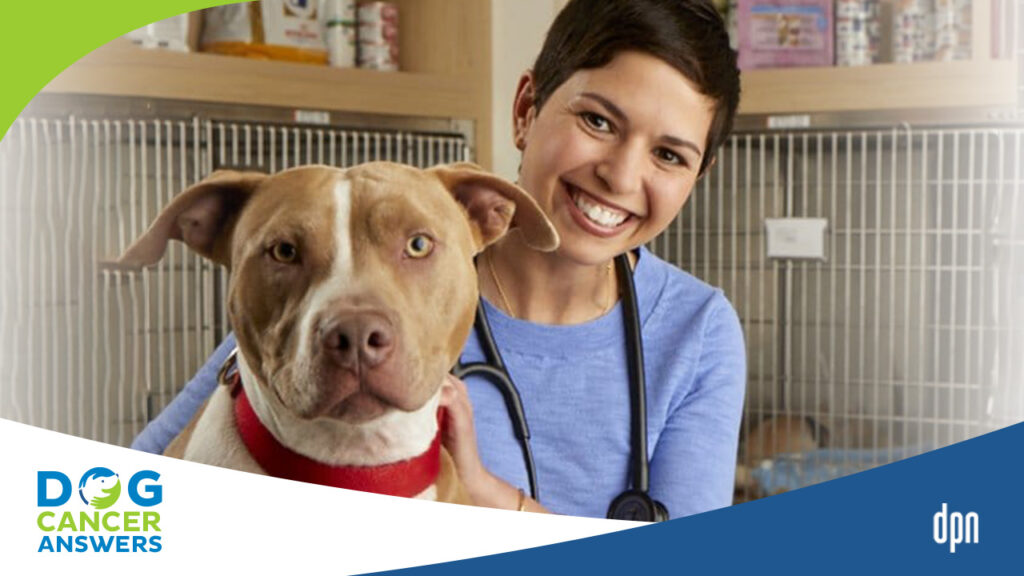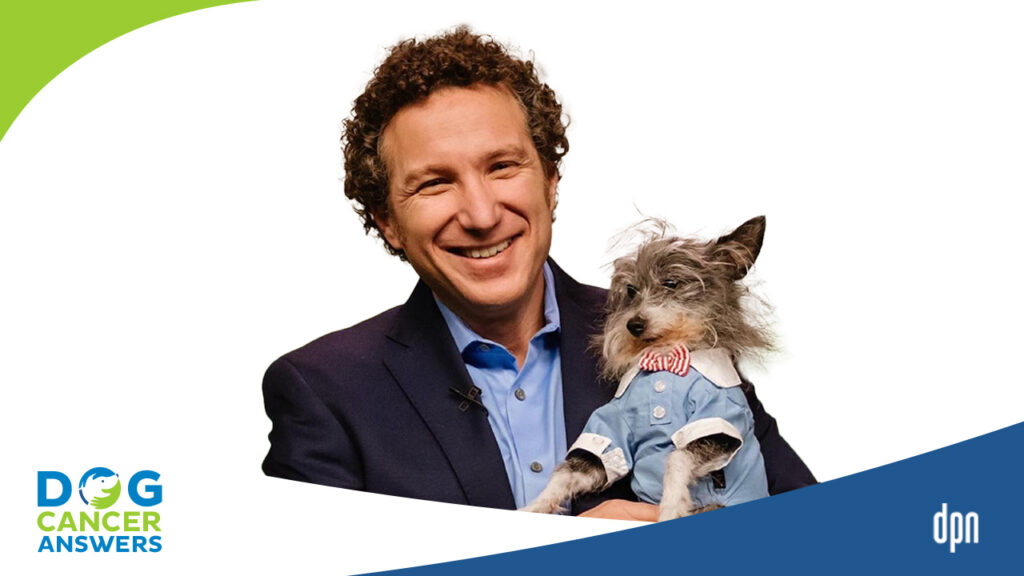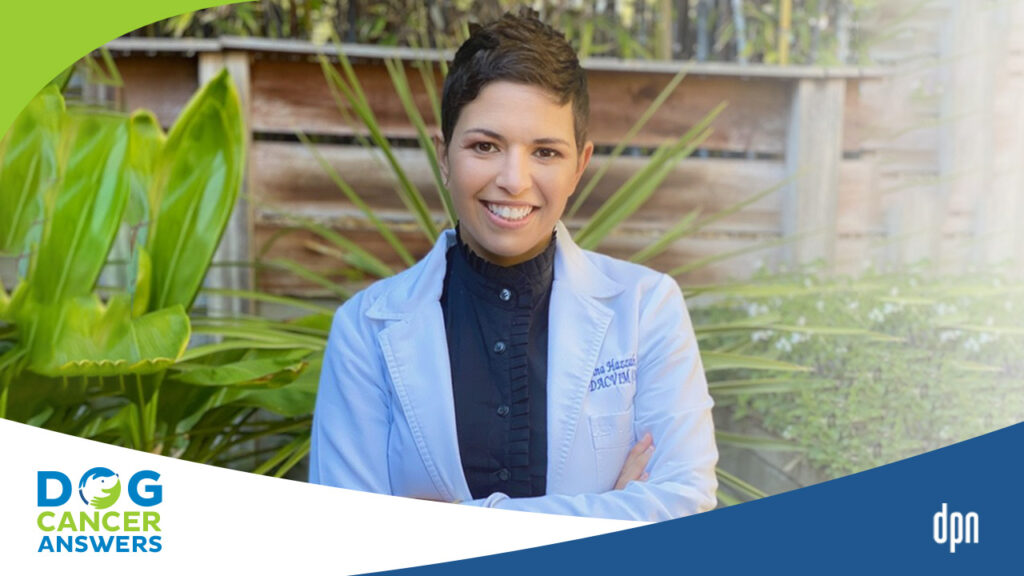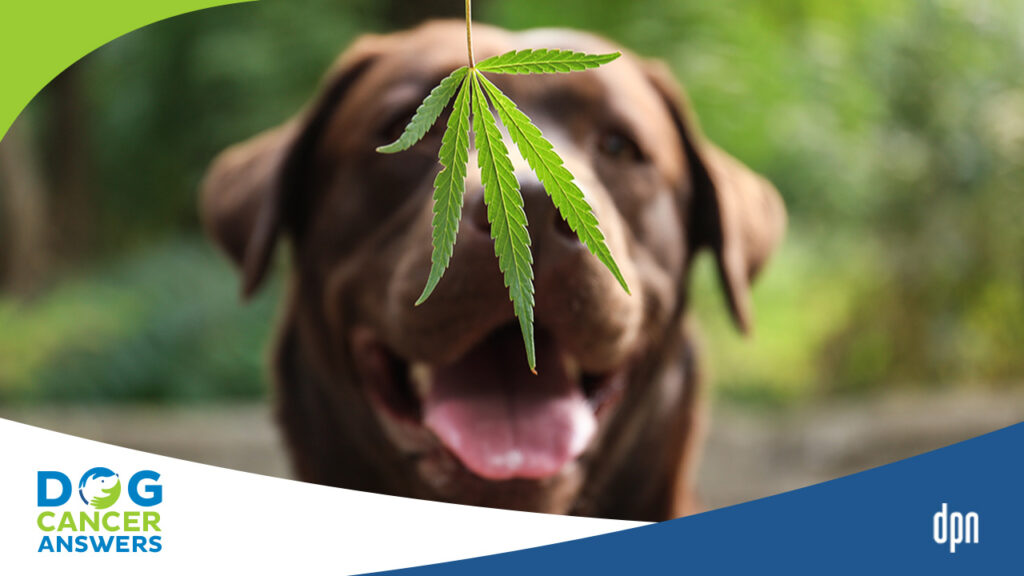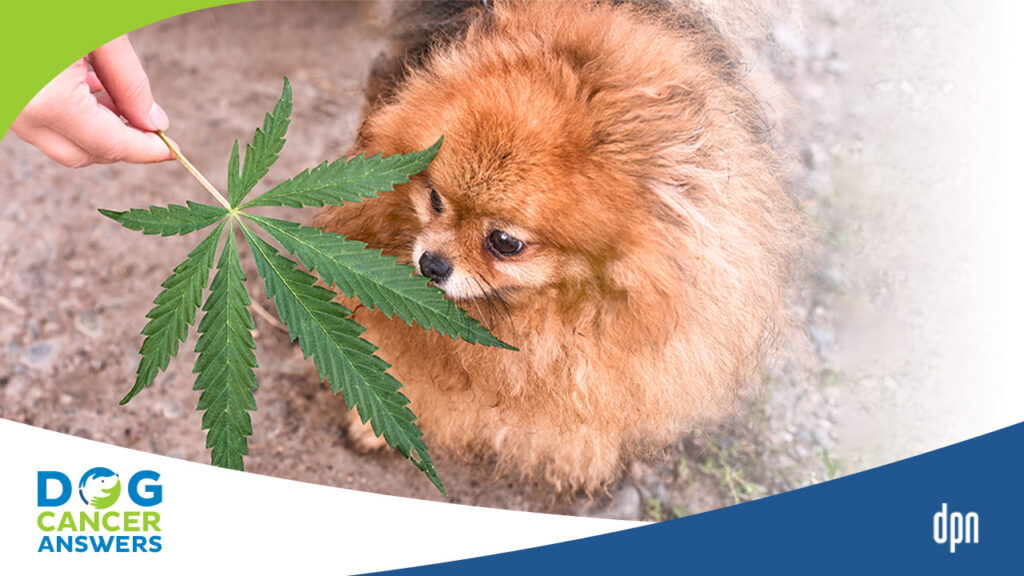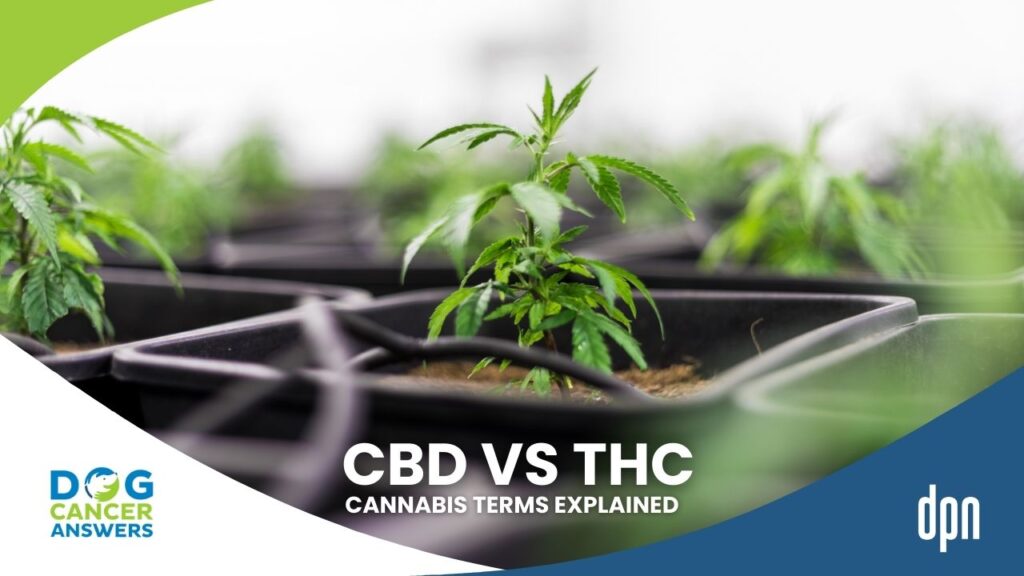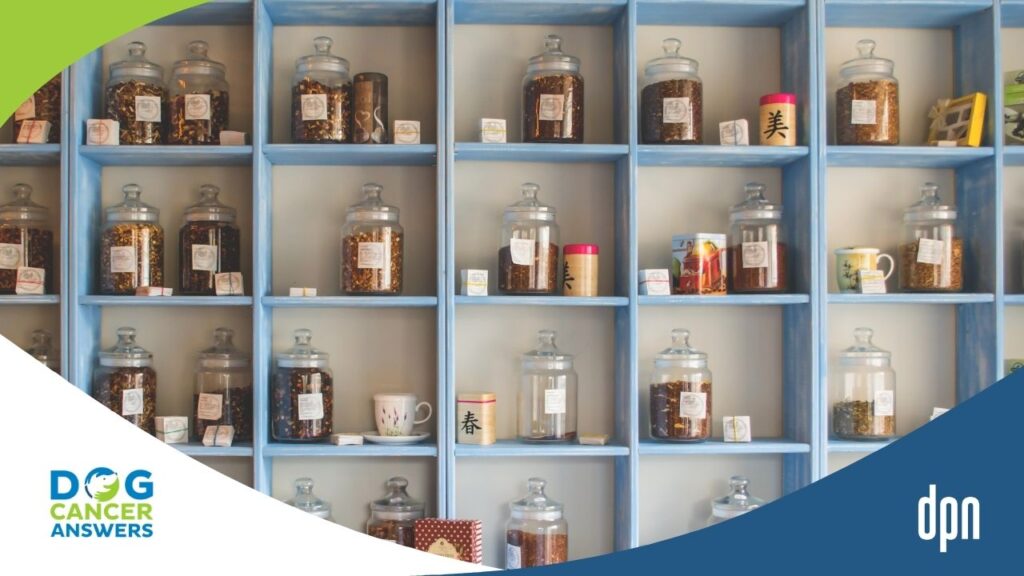EPISODE 220 | RELEASED June 12, 2023
CBD and Cannabis for Dogs: Then, Now, and Looking Forward Part 2 | Dr. Narda Robinson
CBD might be part of the natural dog cancer treatment plan for your pup, but it is important to choose your product(s) carefully.
SHOW NOTES
This is Part 2 of our discussion of cannabis and CBD for dogs with Dr. Narda Robinson. In this episode Dr. Narda discusses how CBD can fit into a cancer treatment plan, the legal complications of cannabis in veterinary medicine, and some tips for choosing a product.
Some things to look for when researching products are a Certificate of Analysis, how the product is processed, sustainability and environmental impact of the growing operation, and what your pet’s specific needs are. In her experience oils are the most reliable and have been studied the most, though many dogs love their CBD chews!
Salves are an emerging option that Dr. Narda likes because they can be used to target specific painful areas. However, there are not any products available right now. If considering a human CBD salve for your dog, review the ingredients carefully with a holistic or integrative vet. Many of the essential oils that we love for ourselves can be dangerous for our pets if they are licked or absorbed into the skin.
Listen in to hear how Dr. Narda determines if CBD is appropriate for a dog, how it might be able to help your pup, and why discussing these products can be a challenge depending on where you live.
Links Mentioned in Today’s Show:
CBD and Cannabis for Dogs: Then, Now, and Looking Forward Part 1 https://www.dogcancer.com/podcast/supplements/cbd-and-cannabis-for-dogs-then-now-and-looking-forward-part-1-dr-narda-robinson/
ElleVet Sciences https://www.ellevetsciences.com/
Related Links:
Cannabis to Help Dogs with Cancer – A Veterinary Oncologist Perspective podcast episode
How Does PEMF Therapy Help Dogs with Cancer? podcast episode
Cannabis vs CBD and Related Terms podcast episode
[00:00:00] >> Dr. Narda Robinson: So the whole thing, the social, environmental, nutritional – and it’s for the people too. If there’s a conscientiousness about living well, that should be for all inhabitants in that household. And yeah, I mean, that’s what life’s about. It’s not just be popping pills all the time, natural or not.
[00:00:18] >> Announcer: Welcome to Dog Cancer Answers, where we help you help your dog with cancer.
[00:00:25] >> Molly Jacobson: Hello, friend. I’m Molly Jacobson. Today on Dog Cancer Answers, we have Part Two of my conversation with Dr. Narda Robinson about cannabis and CBD for dogs. Dr. Narda is a veterinarian and osteopath from Colorado who has a passion for integrative medicine. If you haven’t already, I recommend going back and listening to Part One.
This part of our conversation focuses on some of the specifics of cannabis and dog cancer treatments, as well as lots of insight on the types of products available and how to choose one for your dog. And now let’s go back to our conversation with Dr. Narda Robinson.
So we’ve talked about, we’ve talked about seizures, we’ve talked about pain and inflammation. Is there anything else to say about those two topics when it comes to anything about dogs specifically or any other uses as an anti-inflammatory and pain control?
[00:01:19] >> Dr. Narda Robinson: Yeah, well, a natural other thing is about cancer, so that’s a question too, because we know that cancer is sometimes something that arises after chronic inflammation.
[00:01:31] >> Molly Jacobson: Right.
[00:01:31] >> Dr. Narda Robinson: So cannabis in general has some actual anti-cancer effects beyond the anti-inflammatory benefits, and there’s antioxidant benefits, and balancing the immune system, and then if there was cancer, then of course the analgesia or the pain control of it. So, you know, and, and, but then you can go down that road too much and somebody might think, well if this has any anti-cancer benefit, I’m gonna have my animal on that their whole lives so that they never get cancer, and that’s just what I’m gonna do. ‘Cause we see some people do that with various herbs.
But, you know, so then, then there’s questions about that too, like how are you throwing off their liver for a long-term effect? So we don’t know what the long-term damage might be, if there is any. So really to put an animal on something their whole lives is not that great to do. We, we need to see what’s in it. And then if you had a product that maybe wasn’t so well developed, and if there were heavy metals in it, for example, you’re gonna have them on that for their whole lives.
So that again, gets back to organic and analyzed well for heavy metals, for contaminants during the process. Because cannabis is one of those plants that has been used for environmental cleanup.
[00:02:51] >> Molly Jacobson: Right.
[00:02:51] >> Dr. Narda Robinson: Because it takes a lot of stuff out of the soil. And so then that concentrates in it. So that’s again, where these things have to be analyzed to be safe. So.
[00:03:04] >> Molly Jacobson: So my understanding is that when a company is using extracts, they can kind of clean the batch for, they can test for pesticides and herbicides and not use products. If they’re ethical, they don’t use things that are contaminated. Is that what you have found? Do you believe that? Do-
[00:03:21] >> Dr. Narda Robinson: Well, I think it, it just matters on the source that they’re taking it from. So, so of course is it organic? So there’s what’s the plant stuff that’s coming out, but then also how are they extracting these oil-based or, you know, these oil soluble chemicals. And so that’s where like you could do butane or you could do safflower oil. So when that’s there, or, or, or carbon dioxide when it’s there, then how is it then put through processing to remove that and then to test what’s at the end.
So certain companies are very proprietous about where they’re getting their strains. I mean, it’s like that’s their copyright in a way. So some of them aren’t as transparent about how much CBD is in there, or the precursor CBDA, so what’s in the plant before it becomes CBD, there’s an acid part to it that gets cleaved off with heat. But if you keep that in, that has its own anti-inflammatory effects. So it’s very interesting.
But that can be where it’s frustrating to know the balance because they might not wanna disclose that. So, but in a good Certificate of Analysis you’ll see, I mean, it can be pages of things, and how many microbes, because you don’t want germs and things in there, fungi and everything. So it should be that things either were removed or they were never in there in the first place. But I think you were also kind of edging on another issue with cannabis, and that is the impact on wildlife.
So if you’re not in a warehouse in Denver, growing your stuff under lights – I mean, just like what’s the environmental impact of growing? So how much electrical consumption is there versus the sun? What about water? And, and is that reused? But also if you have fields of cannabis outside, you know, that’s bad for wildlife because they will often set, you know, have poison or have, you know, rodenticides or whatever to kill off wildlife so that they don’t consume this very valuable crop.
And so that’s a real negative thing. So it’s, it’s misleading because we think, oh, this is a green product. Well, it’s not as environmentally friendly a lot of times as we’d like it to be, and so I think we need the full picture and whatever product we buy, we should consider what’s the environmental impact of whoever grew this in the first place.
[00:05:43] >> Molly Jacobson: Okay. All right. I wanna make sure that we cover, specifically about cancer, when would you consider using a cannabis product with a dog with cancer? Are there times when you wouldn’t, are there times when you would, what kinds of products, like oils versus chewables versus, you know, and how you, how you assess that. Like how, as a clinician do you assess that? What do you teach other clinicians to do?
[00:06:10] >> Dr. Narda Robinson: Yeah. Well, once you have a, a good product in mind, which I do, I mean, you can find out who’s doing which research.
[00:06:16] >> Molly Jacobson: Yeah, I’d like to talk about products as well, but yeah.
[00:06:18] >> Dr. Narda Robinson: I know, it’s kind of tricky.
[00:06:20] >> Molly Jacobson: Okay.
[00:06:20] >> Dr. Narda Robinson: Um.
[00:06:20] >> Molly Jacobson: All right.
[00:06:21] >> Dr. Narda Robinson: I mean, I don’t know. I don’t mind, but, um, but anyway, so I would say, well, what is the problem that the animal is having? I mean, is there pain? Is there immune dysfunction? Is there lack of appetite? Because appetite is another thing that these things can be helpful for. So, I would be fine trying it more proactively than not, except that I would also just want to be cognizant of an herb drug interaction.
So if they’re getting chemotherapy, then, probably, I mean, it, it would be a judgment call. ‘Cause we, we don’t clearly know how much it might interact with certain of these drugs. But one option for any herb or supplement is to back down on or stop it. When you’re co-administering when there’s chemotherapy, or if they’re having radiation therapy or surgery, then how is a drug that might change the metabolizing properties of the liver, so it might change the way a system handles other medications to raise that drug or to lower it.
So you could get an unpredictable amount of conventional drug in the system when you’re introducing an herb.
[00:07:33] >> Molly Jacobson: I see.
[00:07:33] >> Dr. Narda Robinson: But same happens with certain pharmaceuticals like phenobarbital and tetracycline and things. So that would be my main concern, is just not unconsciously mixing it with drugs, but to, if they need it for quality of life, then I think you could make that judgment, okay, we’ll we’ll do it together. But I don’t see a problem with animals with cancer having it other than you just wanna be careful.
[00:07:56] >> Molly Jacobson: Are there specific drugs that you’re concerned about mixing with, with cannabis products?
[00:08:01] >> Dr. Narda Robinson: Well, I think we don’t know enough yet, but, you know, so many drugs are processed by the liver.
[00:08:07] >> Molly Jacobson: Right.
[00:08:08] >> Dr. Narda Robinson: And so, CBD, I mean, you’re mucking a little bit with the enzymes that would break down a drug or maybe break it into a more active drug. So we don’t have a clear enough picture yet, but even when they started to do that anti-seizure study at CSU and they were already on these other drugs, the neurosurgeon that was leading the study just clinically didn’t really see a difference in the seizure control.
Like she didn’t think that it was negatively impacting it. I don’t know – they were probably monitoring phenobarb levels and different things, but we know the phenobarbital induces liver enzymes or it increases it. So that one’s mucking with liver enzymes too. I mean, yeah, and it, it’s like, well, maybe we don’t know everything, but maybe we know enough that it’s not gonna be the hugest deal in the world.
[00:08:59] >> Molly Jacobson: Right.
[00:08:59] >> Dr. Narda Robinson: If an animal gets this and they feel better through it, they live better through it, and they can actually survive the anti-cancer treatment. So, I think it’s just, can we be flexible and animal patient centered and do really what’s best for them rather than hiding in a corner and saying, oh, I don’t know what to do with an herb.
You know? Or on the other hand, like willy-nilly prescribing herbs, that you’re just only thinking about energies and mysticism and you have no clue about their pharmacology or the fact that you’re giving strychnine in an herbal product.
[00:09:31] >> Molly Jacobson: Right. That’s a good example.
[00:09:33] >> Dr. Narda Robinson: Yeah. Thank you.
[00:09:34] >> Molly Jacobson: Um, I have a question about the anti-inflammatory properties of CBD. When given orally, is it going to have the same – ’cause generally you don’t wanna give two anti-inflammatory substances at the same time because the risk of GI side effects increases. Right?
[00:09:52] >> Dr. Narda Robinson: Right.
[00:09:52] >> Molly Jacobson: So how does CBD fit into that picture?
[00:09:55] >> Dr. Narda Robinson: Well, it has a more complex mechanism of action. It’s not like it’s going to, like your traditional anti-inflammatories, you know, block the production of certain enzymes and then, you know, inhibit pro-inflammatory things. It’s more working, I mean, I think it’s not fully known yet, but it’s more working with the endogenous or internal mechanisms that are anti-inflammatory in part by calming down the nervous system and the immune system so that it’s not so easily triggered.
[00:10:24] >> Molly Jacobson: Ah, okay. Okay. So it’s anti-inflammatory, not necessarily like, kind of in a brute force way where it says, "You’re doing the wrong thing, stop," and it just blocks receptors or degrades chemicals that the inflammation is associated with. But instead it’s going to the parts of the body that regulate inflammation-
[00:10:44] >> Dr. Narda Robinson: Yeah. Yeah.
[00:10:45] >> Molly Jacobson: -and saying, "Let’s calm down. Let’s take it easy. Let’s maybe not produce so much inflammation." So it’s a different, it’s on the, a little bit more at the root of the matter rather than on the end product of inflammation.
[00:10:56] >> Dr. Narda Robinson: Yeah. Like the COX-1 and COX-2 inhibitors, it’s, it’s not like that kind of abrupt stoppage like that. It may have some effects on that, but you know, you also have this lipoxygenase system that, I mean like essential fatty acids, they, they help produce chemicals that help the body in the inflammation resolution phase. So when we’re working well, yes, we get inflammation to address an injury and that walls off the area and all, and just stops us from using that area.
But inflammation doesn’t just dissipate. We have active processes within our system that then stop the inflammation and clear it out. So yeah, there’s so much more to the process than just like, okay, everybody stop what you’re doing right now and I’m gonna give you this, oh yeah you might get an ulcer because of it, but-
[00:11:44] >> Molly Jacobson: Okay.
[00:11:45] >> Dr. Narda Robinson: -aren’t you glad you don’t have inflammation anymore?
[00:11:48] >> Molly Jacobson: So I think I’ve asked you this already, but I wanna be sure. Is there anything that you would not use CBD alongside? Is there any drug or any situation other than the chemo and radiation where you would be consciously like really analyzing those drugs in that process?
[00:12:07] >> Dr. Narda Robinson: Yeah, I mean, not that I can think of right off, but there are now thoughts about, I mean, this would be rare, but there was a case report about a dog that got like a serious skin reaction to CBD. So this can happen, again, with any kind of product.
[00:12:23] >> Molly Jacobson: Right.
[00:12:24] >> Dr. Narda Robinson: But if something is not going well, or, or that animal is not tolerating the product well, or like with a cat, if they’re hiding under the bed all the time and you can’t administer it, and, and that’s quality of life. I mean, I wouldn’t do it for that reason, but in general, my go-to approach for helping animals heal is less in the pharmacology realm than the non-pharmacology. Like before, if we had an old dog with arthritis, wasn’t eating well, wasn’t moving well, we could use something else. I’d have CBD preparations on my radar.
But before I would do that, I’d be doing acupuncture, massage, laser therapy, therapeutic exercise. I would rather not muck around pharmacologically if I didn’t really have to. There’s so much we can do with the body’s own internal chemistry, internal pharmacopeia, and maybe add a rescue preparation. So rescue in terms of they need a little bit more.
So here you can have this, we don’t have to do it every day, but you know it’s damp out or you add too much exercise, here, let’s do this. Let’s get you over the hump. Even if it was a pharmaceutical, it’s like, okay, here you go. But we don’t need to just rely on that and that’s all we got, you know, this thing that comes out of a nice white bottle, here’s your chewy or whatever.
But there are so many benefits beyond what that medicine can do that is really structurally important. Releasing the fascia, improving circulation. We’ve talked about that before, that no drug can compare with, no CBD product, no, even if it was a little bit more cannab- THC or whatever. I mean, so the way I look at it is, what are the problems the animal has?
What’s the mechanism of the disease? How can we best match that mechanism of, with mechanism of healing to bring them to a better state? And thinking about all the rational science-based ways that various integrative modalities and conventional ones work. So what makes the best match and how do we manage that over time and change things as needed.
[00:14:30] >> Molly Jacobson: That’s a great framework to understand how to approach life as well as medicine, right? That.
[00:14:38] >> Dr. Narda Robinson: Yeah.
[00:14:38] >> Molly Jacobson: Let’s see what we can do with the body itself that’s not interventional, but just as supporting, and shoring up the body’s own resources. And then add things as necessary and do the least invasive first and build from there.
[00:14:55] >> Dr. Narda Robinson: Yeah.
[00:14:55] >> Molly Jacobson: So that you add more support if needed.
[00:14:57] >> Dr. Narda Robinson: Yeah.
[00:14:58] >> Molly Jacobson: I think we get really, um, I don’t know if this is unique to Americans. I suspect this is partly cultural. We really like to buy something that will fix a problem. We’re a consumer society.
[00:15:11] >> Dr. Narda Robinson: Yeah.
[00:15:11] >> Molly Jacobson: And we think, oh, I have a problem, what is the thing I can buy to solve it?
[00:15:16] >> Dr. Narda Robinson: Yeah. Well, right. Well they could buy a PEMF bed, a pulsed electromagnetic field bed, uh, you know, or a Loop, or a, a handheld laser, or LED device. So certainly stuff you can buy, so to meet that need, ’cause I like online shopping very much. But, um, but yeah, and then also looking at the environment, like, you know, are the parents going through a divorce?
Are the kids too noisy? Is there a television blaring all the time? So the whole thing, the social, environmental, nutritional – I mean it, and it’s for the people too. If there’s a conscientiousness about living well, that should be for all inhabitants in that household. And yeah, I mean, that’s what life’s about. Let’s not just be popping pills all the time, natural or not.
[00:15:59] >> Molly Jacobson: Right. Exactly. We’re gonna take a short break here and then when we come back, I wanna talk about specific CBD brands and products for dogs.
And we’re back with Dr. Narda Robinson. Okay. I wanna talk a little bit about brands that you trust, and also about whether dogs do better on an oil versus a chew based product or any other type of product. I don’t think there’s any other thing else for dogs. But yeah.
[00:16:30] >> Dr. Narda Robinson: I mean, I think a big area for cannabis for animals is, are salves, but we can come back to that. Um.
[00:16:37] >> Molly Jacobson: Okay. Yeah.
[00:16:38] >> Dr. Narda Robinson: I, I mean far and away, I don’t think it’s disputed at all that ElleVet, E L L E V E T, I mean that, from what I can see, is a leader in terms of who has done the research, who is working with university people and, and publishing. So what we don’t have is a side by side comparison. I mean, there could be even better preparations out there from other people.
[00:17:03] >> Molly Jacobson: But they haven’t done the studies and the publishing.
[00:17:06] >> Dr. Narda Robinson: Right, right. Well, sometimes, I mean, they might have a study or two on something, but you know, if you had a population of dogs with seizures or post some kind of surgery or something and they got product A or product B, or a placebo, which would be sad, you know, but that’s research, so you’d need side by side comparison.
But then it’s like, oh, here’s somebody, let’s say that made this salad versus this salad. I mean, because it’s not that you’re just changing, it’s not just, here’s one chemical versus one chemical. But still, you could do this chemical, this manufacturer’s thing, product A, product B, and whatever. Or you know, your usual conventional medication so that they’re not without something. So that could be done, but that’s not done.
[00:17:52] >> Molly Jacobson: Why not? Money?
[00:17:54] >> Dr. Narda Robinson: Yeah. Probably.
[00:17:55] >> Molly Jacobson: Nobody wants to pay for it unless they have a financial reason to have that study.
[00:18:00] >> Dr. Narda Robinson: That’s often it. I mean, maybe somebody’s doing it right now, but I have never seen a study like that.
[00:18:06] >> Molly Jacobson: Okay.
[00:18:06] >> Dr. Narda Robinson: And then when it comes to type of preparation, this is something that we were thinking about when we were starting the research at CSU because like, I’d rather eat a cookie than have somebody squirt a dropper full of strange smelling thing in my mouth.
[00:18:21] >> Molly Jacobson: Right.
[00:18:22] >> Dr. Narda Robinson: But, um, you know, when, if you put it in a cookie or something, how does it change? So how does the batch get mixed up, is it evenly distributed through the biscuit? Um, what happens when you cook it again? What’s the shelf life? So it changes. It’s not as stable and reliable a preparation-
[00:18:44] >> Molly Jacobson: Okay.
[00:18:44] >> Dr. Narda Robinson: -as it is in an oil. And based on what I’ve seen, I, I, at least some of the research, it looks like it’s the oil-based stuff. But, you know, ElleVet might have, you know, research that shows that there’s a capsule, but I, I tend to think it’s gonna be an oil-based preparation. But the salves, um, again, being a Colorado-
[00:19:02] >> Molly Jacobson: Can I ask you a question about the oil?
[00:19:03] >> Dr. Narda Robinson: Yeah.
[00:19:04] >> Molly Jacobson: Can you just add it to their food and mix it in? If they are a clean the plate kind of dog, if you are confident they’ll eat everything?
[00:19:12] >> Dr. Narda Robinson: Yeah. Yeah. Some are less discriminating. I don’t see why not unless – I haven’t kept up with, I don’t know if there’s a thing, like you want it on an empty stomach or not. I don’t see why, I mean, if you’re gonna have edibles, that’s not an empty stomach.
[00:19:24] >> Molly Jacobson: That’s not an empty stomach. Right.
[00:19:26] >> Dr. Narda Robinson: Like defeating the purpose. Um, you know, I mean, even for, I mean, you get into like rabbits and horses, that would forage on some of this stuff, and, and maybe it’s raw and so it hasn’t been converted yet. So I think there’s so many cool things to think about in terms of just like if they were out in a field, yeah, they might have a little nibble or something. You get into the idea of zoopharmacology where animals are drawn to certain medicinal plants when they have even certain conditions, that they more access certain things.
So if only we hadn’t destroyed the environment like this and there were fields with a lot of diversity and animals were free to roam and all that, that would be so nice. So anyway, um.
[00:20:09] >> Molly Jacobson: So salves, you were gonna talk about salves.
[00:20:11] >> Dr. Narda Robinson: Salves. Salves I, I think are great, and especially being in Colorado and having access to a variety of salves – not all – that are THC free. So I’m not saying we should lather dogs with butter with THC on it. So we would still want to stay in the low or no THC kind of thing for, not for dogs. But from a human perspective – ’cause I have been registered with the state of Colorado as somebody that could write a prescription for medicinal marijuana but I, I’m letting that lapse because it’s like why bother? Um, people can just go, it’s-
[00:20:42] >> Molly Jacobson: People don’t need a prescription anymore in Colorado.
[00:20:43] >> Dr. Narda Robinson: People don’t need a prescription. Yeah. So in some of my human patients, it’s like, well, if you have knee pain, you don’t need to ingest stuff, get it all through your system, deal with the liver processing and everything. Get a salve of whatever makeup that, and I would discuss it with them, and put it on your knee so that your endocannabinoid receptors, if there is THC in it, they will be right there. That’s where you need the pain control.
[00:21:09] >> Molly Jacobson: That makes sense.
[00:21:10] >> Dr. Narda Robinson: And yeah, my patients won’t be licking their knee, whereas a dog could. But if, if still, if that composition of the salve was not injurious and did not have record levels of some kind of product in it, you know, some kind of very hallucinatory cannabinoid, it’s not a big deal.
[00:21:29] >> Molly Jacobson: Are there salves available that you would use with a dog as opposed to a human?
[00:21:34] >> Dr. Narda Robinson: I mean, there’s no, as far as I know, there’s no veterinary salves.
[00:21:37] >> Molly Jacobson: Okay.
[00:21:37] >> Dr. Narda Robinson: But I don’t see a problem with – if a predominantly CBD salve. But I, I don’t think people are exploring that yet, but I, I think it’s just really a great idea.
[00:21:47] >> Molly Jacobson: Is there a, um, ’cause I know there’s so many human salves now, I mean, you can get an entire skincare line that’s filled with cannabis products, right? So.
[00:21:58] >> Dr. Narda Robinson: In the supermarket!
[00:21:59] >> Molly Jacobson: Yeah, yeah.
[00:22:01] >> Dr. Narda Robinson: Yeah.
[00:22:01] >> Molly Jacobson: So what, like if I, if I have a dog who’s really arthritic right now, or in some sort of like, I feel like they’re in a lot of pain, and it’s local. It’s not systemic, but it’s local. And I feel like I could probably just give, like, put a little salve on my dog’s hip, what would I look for?
[00:22:19] >> Dr. Narda Robinson: I mean, I, I’d want to see what exactly was in there, because a common inclusion herbally in salve type things for humans is comfrey. So I’d wanna know what the vehicle was. So, you know, everything in there. Like let’s assume they’re going to lick it off. Is any of that toxic? And-
[00:22:40] >> Molly Jacobson: And comfrey is to dogs?
[00:22:42] >> Dr. Narda Robinson: Comfrey is, yeah. It has pyrrolizidine alkaloids in it that are hepatotoxic, so liver toxic, thought maybe that there’s a potential link with cancer.
[00:22:51] >> Molly Jacobson: Okay.
[00:22:52] >> Dr. Narda Robinson: So we really don’t want that in there and, but you know, it has pretty little flowers and-
[00:22:57] >> Molly Jacobson: Yeah. It looks nice.
[00:22:58] >> Dr. Narda Robinson: So people won’t know. It could be like, oh, this is all herbal, and it might have really toxic pennyroyal in it. I mean, so that’s the issue. So yeah, I’d feel more comfortable if there was a product manufacturer that was for veterinarians or veterinary use that had just, you know, it’s just kind of like, um, I don’t know, just some kind of safe oil. It was flaxseed oil or something.
So there’s, there’s always something, but we’re, we’ve come a such a long way in not a very long time to be able to increase these options and make drug companies nervous about losing some of their market share.
[00:23:34] >> Molly Jacobson: Yeah, for sure. Or interested in, in patenting all of the little molecules and-
[00:23:39] >> Dr. Narda Robinson: Right.
[00:23:39] >> Molly Jacobson: -taking it out of the farmer’s hands.
[00:23:41] >> Dr. Narda Robinson: Yeah. Right, right.
[00:23:42] >> Molly Jacobson: Yeah. Uh, what a complex, um, yeah, and just to put a button on it, ’cause I know how frustrating it is for folks whose veterinarians won’t talk about these products at all. And so I, I just want to ask you if you could defend that choice a little bit on the part of a veterinarian ’cause-
[00:24:06] >> Dr. Narda Robinson: Oh yeah.
[00:24:07] >> Molly Jacobson: Yeah.
[00:24:08] >> Dr. Narda Robinson: Right. No, I have, I have a, um, continuing education program that’s like 20 hours on cannabis, uh, in veterinary medicine. And one of the 10 modules is on legal considerations. So I ask them to research from their own state board what are their guidelines. And there are states, particularly in the southeast of the United States, where you can lose your license if you even discuss, even if you raise the – it’s like, well, okay, first amendment, uh, anyone, you know. So I mean, it’s enough of a precarious situation what’s going on in the country already.
But yeah, they would be in a lot of trouble. So it’s legitimate that some are very concerned. I know when I was spending some time in Canada, 2016 and later, that, uh, you know, there, there was a question because a lot of Canadian veterinarians thought that the CVO, College of Veterinarians of Ontario, that’s their regulatory body, CVO, they thought that they were saying it would be illegal to discuss it at all.
And they were more like, no, it’s just you can’t prescribe it. You can’t sell it in your practice. And that’s still a lot of what’s in the US, although things have changed and, you know, hemp has been reconsidered. But yeah, it’s, it’s like if you don’t, that we, for in general, we don’t know what the safe doses are.
Yes, ElleVet has done a lot of research and other companies have done some research, but that’s with their product. We can’t say that every other product and whatever is safe. So we are really still at the beginning and it’s still a cannabis derivative, so just the, I, this will be my last little story, but we were at a AVMA, American Veterinary Medical Association, meeting several years back, and it was when I was probably at the height of my involvement with CSU and cannabis and, um, there was a DEA agent there.
And so I forget who we got to go up to her and say, "What would happen if we gave an animal CBD?" She goes, well, essentially you’d lose your license because it’s still a cannabis derivative. So I don’t know. You know, there’s all these acts and CBD is like, okay, it’s hemp, and if it’s this, that, then, okay, we’ll look the other way. But I mean, going from Colorado to Wyoming, um, things can change very suddenly over the border there, so.
[00:26:28] >> Molly Jacobson: And until it’s off Schedule One-
[00:26:30] >> Dr. Narda Robinson: Yeah.
[00:26:30] >> Molly Jacobson: -the DEA has the right to enforce the federal law in every state. Even if they are currently kind of turning the other way, they, that is still a risk. Hopefully they will not, but that’s, you know, it’s a federal, it’s a federal, it’s not a state. So the fear is real for veterinarians.
[00:26:51] >> Dr. Narda Robinson: It is real. And, and you have certain organizations, I think it’s like the Veterinary Cannabinoid Academy, and that they certify people. I mean, all, all certifications are kind of self-appointed and it’s not like any state is saying, yeah, you go people and you do that, but that’s the thing – like people can find, you can access products typically, I mean, maybe you, I don’t know, maybe there are states that you would get in trouble if they found it in the mailbox.
I don’t, there are other things they’re regulating more heavily I think right now, but I mean, you can find so much stuff yourself. And move to Colorado. We’re-
[00:27:28] >> Molly Jacobson: Right.
[00:27:29] >> Dr. Narda Robinson: I can get organic, you know, 10 minutes away. And so anyway.
[00:27:34] >> Molly Jacobson: Maybe someday. Maybe someday we’ll all be enlightened.
[00:27:37] >> Dr. Narda Robinson: Yeah.
[00:27:38] >> Molly Jacobson: And uh, yeah, that is a, it’s a tricky one. So.
[00:27:42] >> Dr. Narda Robinson: It is tricky and people shouldn’t think it’s not tricky, ’cause it’s still tricky.
[00:27:45] >> Molly Jacobson: Yeah. I feel bad for veterinarians who sort of can’t discuss it at all and then their clients get really angry and think they’re resistant. And often they’re not at all resistant. They’re reading the same-
[00:27:57] >> Dr. Narda Robinson: That’s right.
[00:27:57] >> Molly Jacobson: -stuff that you’re reading and they’re going, I wish I could work with this, but it’s too risky for me and my family.
[00:28:02] >> Dr. Narda Robinson: That’s right. And so what, what do people end up doing? I mean, in the dispensary 10 minutes away, if I said, I’m a client, I need something, my dog has back pain and they, you know, this person who has not gone to vet school, is probably not a veterinary technician. Or, you know, go to a pet big box store or something.
[00:28:19] >> Molly Jacobson: Sure.
[00:28:19] >> Dr. Narda Robinson: Here, take this. You know, so the clients are left getting advice from people that don’t have any veterinary background.
[00:28:27] >> Molly Jacobson: Right. And there is a difference between the way things happen in the dog’s body versus the human body versus the cat’s body.
[00:28:34] >> Dr. Narda Robinson: Right.
[00:28:35] >> Molly Jacobson: And veterinarians have that knowledge of all these different animal systems and how they work, and they’re all very different, which is why I had a, I had a friend who’s a doctor, and he said, oh, when I figured out what veterinarians have to go through, I decided to go to medical school. Because he’d be like, just learning one system is hard enough.
[00:28:54] >> Dr. Narda Robinson: Right.
[00:28:55] >> Molly Jacobson: Having to learn so many others.
[00:28:57] >> Dr. Narda Robinson: Right, right. And the diseases and, and think about the drugs that they’re on and they, yeah. So, yeah.
[00:29:03] >> Molly Jacobson: Yep. So interesting. I think veterinarians have to be very open-minded in some ways and yet are often accused of being close-minded. So I just wanted to put a little pin in that, that sometimes they have other reasons for just not discussing things like cannabis.
[00:29:18] >> Dr. Narda Robinson: Yeah, definitely. I’m glad we touched on that ’cause that it is a big issue in certain states.
[00:29:23] >> Molly Jacobson: Yeah. Well, thank you so much for joining us today, Dr. Narda Robinson. As always, it’s a pleasure.
[00:29:30] >> Dr. Narda Robinson: Same here. Yeah. Always love to see you guys.
[00:29:34] >> Molly Jacobson: And thank you, friend, for listening. I hope you have enjoyed this series as much as I did. We sure covered a lot of ground from how cannabis research in dogs got started, to how it can help your dog and the customization and different products we might see in the future.
We have many more interviews and resources about cannabis and CBD for dogs. And you can find all of those on our website at dogcancer.com. You can also check out the show notes for links mentioned in today’s episode. And if you’ve used CBD for your dog with cancer, please share your experience in our Facebook support group. That’s Dog Cancer Support. You can find it at dogcancersupport.com, or just search for Dog Cancer Support on Facebook.
I’m Molly Jacobson, and from all of us here at Dog Podcast Network, I’d like to wish you and your dog a very warm, Aloha.
[00:30:27] >> Announcer: Thank you for listening to Dog Cancer Answers. If you’d like to connect, please visit our website at dogcancer.com or call our Listener Line at (808) 868-3200. And here’s a friendly reminder that you probably already know: this podcast is provided for informational and educational purposes only. It’s not meant to take the place of the advice you receive from your dog’s veterinarian.
Only veterinarians who examine your dog can give you veterinary advice or diagnose your dog’s medical condition. Your reliance on the information you hear on this podcast is solely at your own risk. If your dog has a specific health problem, contact your veterinarian. Also, please keep in mind that veterinary information can change rapidly, therefore, some information may be out of date.
Dog Cancer Answers is a presentation of Maui Media in association with Dog Podcast Network.
Hosted By
SUBSCRIBE ON YOUR FAVORITE PLATFORM
Topics
Editor's Picks
CATEGORY
